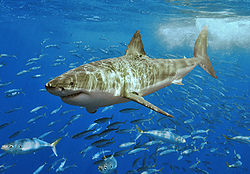The great white shark, Carcharodon carcharias, also known as the great white, white pointer, white shark, or white death, is a large lamniform shark found in coastal surface waters in all major oceans. It is known for its size, with the largest individuals known to have approached or exceeded 6.1 metres (20 ft) in length, and 2,268 kilograms (5,000 lb) in weight. This shark reaches maturity at around 15 years of age and can have a life span of over 30 years.
| Great White Shark | |
|---|---|
 | |
|
Range |
Oceanic Waters throughout the Southern Hemisphere. |
|
Size |
Weight: 680–1,100kgs (1,500-2,400lb) Length: 4-5.2m (13-17.1 ft) |
|
Diet |
Anything it can get it's teeth into. |
|
Weapons and Traits |
The largest predatory shark in the world, has sharp teeth, but is not agressive. |
|
Combat Status |
Victorious over the Saltwater Crocodile |
The great white shark is arguably the world's largest known extant macropredatory fish and is one of the primary predators of marine mammals. It is also known to prey upon a variety of other marine animals including fish and seabirds. It is the only known surviving species of its genus , Carcharodon, and is ranked first in a list of number of recorded attacks on humans. The IUCN treats the great white shark as vulnerable while it is included in Appendix II of CITES
This shark's behavior and social structure is not well understood. In South Africa, white sharks have a dominance hierarchy depending on size, sex and squatter's rights: Females dominate males, larger sharks dominate smaller sharks, and residents dominate newcomers. When hunting, great whites tend to separate and resolve conflicts with rituals and displays. White sharks rarely resort to combat although some individuals have been found with bite marks that match those of other white sharks. This suggests that when another shark approaches too closely, great whites react with a warning bite. Another possibility is that white sharks bite to show dominance.
The great white shark is one of only a few sharks known to regularly lift its head above the sea surface to gaze at other objects such as prey. This is known as spy-hopping. This behavior has also been seen in at least one group of blacktip reef sharks, but this might be learned from interaction with humans (it is theorized that the shark may also be able to smell better this way because smell travels through air faster than through water). The white sharks are generally very curious animals, display intelligence and may also turn to socializing if the situation demands it. At Seal Island, white sharks have been observed arriving and departing in stable "clans" of two to six individuals on a yearly basis. Whether clan members are related is unknown but they get along peacefully enough. In fact, the social structure of a clan is probably most aptly compared to that of a wolf pack in that each member has a clearly established rank and each clan has an alpha leader. When members of different clans meet, they establish social rank nonviolently through any of a fascinating variety of interactions.
A 2007 study from the University of New South Wales in Sydney, Australia, used CT scans of a shark's skull and computer models to measure maximum bite force. The study reveals the forces and behaviors its skull is adapted to handle and resolves competing theories about its feeding behavior. In 2008, a team of scientists led by Stephen Wroe conducted an experiment to determine the great white shark's jaw power and findings indicated that a specimen more than 6.1 m (20 ft) long could exert a bite force of over 18,000 newtons (4,000 lbf). Some scientists believe Great white sharks are related o Megalodon and Chubutensis.
Battle (with Saltwater Crocodile)[]
A female great white shark is roaming close to shore, looking for food; a saltwater crocodile swims nearby, looking for a new territory animal territory. The great white hits the crocodile with the bump-and-bite technique. Accustomed to defending himself against rivals, the crocodile bites the shark's tail, but cannot get a good grip. The shark swims off and makes a wide turn for a full-on assault; all of a sudden, the crocodile gets the first bite on her pectoral fin. The bite tears off the shark′s fin, helped by the classic death roll. Despite the injury, the great white is still strong. Then, the shark and the crocodile collide head on; the crocodile grabs hold of the shark′s snout with his crushing bite. This time, the shark cannot fight back; the crocodile attempts another death roll. After that, they both sink. Running out of air, the crocodile breaks the death roll and heads straight to the surface. The shark takes advantage of him; with the crocodile's soft underbelly exposed, she comes back with a textbook attack, killing the crocodile with a powerful bite.
Winner: Great White Shark